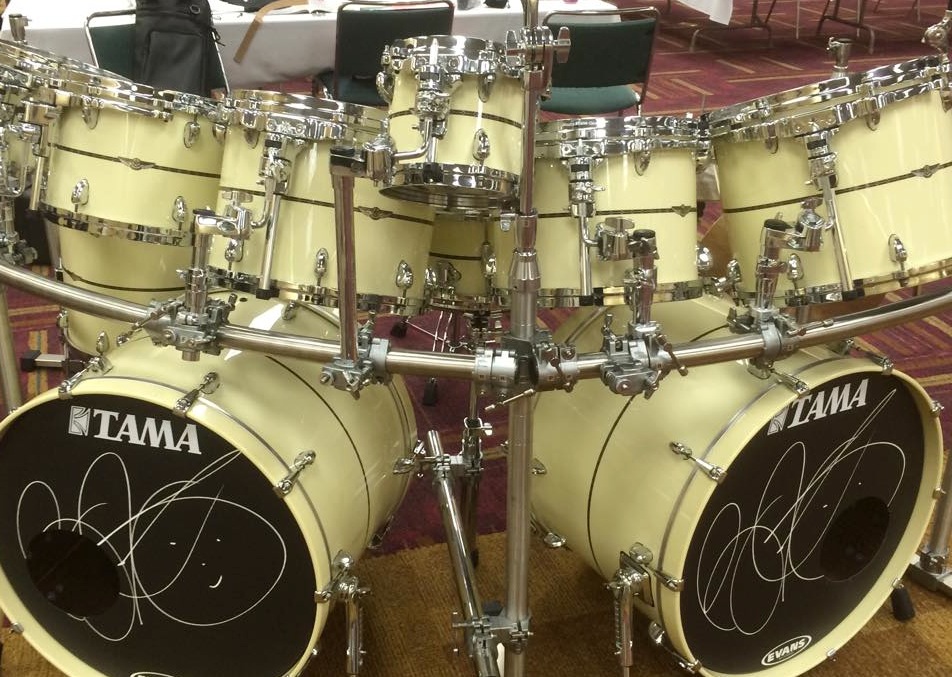


In that way maybe he's more similar to Tony Williams than either of those drummers. We don't often hear a fully integrated linear thing, a la Steve Gadd, or Elvin Jones. The bass drum tends to be used in normal funk ways, and for accents, and ostinatos, often tied to the cymbals. On fills and solos he seems to play a lot of singles, and a lot of open rolls with accented singles. His general approach to playing the drum set could be taken as “snare drummy”- hands-oriented, but modern, not particularly rudimentally based. It may be easier to do that listening to him on records where he's not a leader. Cobham is a great musician and people should understand his playing as normal drumming, doing all the things normal drumming is supposed to accomplish. So it can be difficult to distinguish legit musical energy from just excitement over a spectacular performance, but it's something you have to figure out. I listen to them as music, as creative percussion features: Or you can take them as examples of 70s bloat and “pretentiousness”- a meme from the 70s rock press- like on Crosswinds there's a solo with a lot of flanger on the tom toms, which sounds corny to us now.

You could just hear them as early versions of the modern drum chops display events, opportunities to marvel at his technical awesomeness. On most of his records there are extended open drum features, which you can take a number of ways. This is to me a festival-style performance, designed to blow a festival audience's mind:

In a way he's the prototype for the current high-performance drumming thing.Īnd some of his recordings are like that: parts of them are there to blow away an audience. He can be very flashy and very dense, and it's easy to see how people just take him as pure drumming confection. He plays with a lot of bravado, and is often wildly dramatic. You do have to talk about excitement when you talk about Billy Cobham. If his playing is talked about at all, it's generally in terms of spectacular drumming feats. Drummers today largely talk about him in terms of chops and technique, and he's often mentioned by open-handed drumming enthusiasts. When I was a student in that period, Cobham wasn't one of the first people talked about. In terms of drumming, by the 80s Steve Gadd's concept and sound became the prevalent thing in the fusion and studio drumming. There is a specific overall vibe on his records that you don't really hear any more- fusion music shifted to a different kind of product, and the type of music on Cobham's records has never really been revived among younger players- unlike Miles Davis's 70s thing, for example. Not so much any more, except among Metal drummers. The way he used it was extremely effective, and was widely copied for a long time. The modern, fusion era usage of the Chinese cymbal, with the cymbal mounted upside down, is his thing. With so many tom toms, he can do some pianistic lines not really possible on normal sets, that I haven't really heard from other large-set players. Neil Peart, a totally different type of player, would be another example of that. He's probably the most effective player of a large drum set ever. He was the first major player to play the drums “open handed”, that I know of. He was involved with a number of technical innovations expanding the concept of the drum set as an instrument. He took drumming chops to a new level- maybe not exceeding Buddy Rich, but using more modern drumming language than Buddy. He was on a lot of records, and made a huge splash playing a large drum set in a really exciting way. Take it as a starting place for thinking about what you're hearing when listening to him.īilly Cobham is one of the most recorded and talked about drummers of the first part of the fusion era- from roughly 1970 to 1980. But this should be interesting to read in light of my recent thing on Rufus Jones. I was working on this post about Billy Cobham some weeks ago, and felt I couldn't finish it- it's not that easy to write a complete portrait of the playing of a great drummer.


 0 kommentar(er)
0 kommentar(er)
